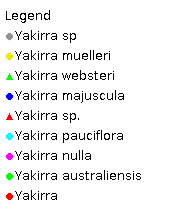Yakirra Brunonia 7: 292 (1984).
Derivation:. The aboriginal name for some species of this genus.
Taxonomic revisions, nomenclatural references:. M.Lazarides and R.D.Webster, Brunonia 7: 289–296 (1984).
Key references (keys and floras):. C.A.Gardner, Flora of Western Australia 1 Gramineae 261–262 (1952) as Ichnanthus; J.P.Jessop, Flora of South Australia 4: 1980 (1986); R.D.Webster, Australian Paniceae 265–270 (1987); T.D.Macfarlane, Flora of the Kimberley Region 1246, 1248 (1992); B.K.Simon, Key to Australian Grasses 176–177 (1993); D.Sharp and B.K.Simon, AusGrass (2002); J.P.Jessop, Grasses of South Australia 495–497 (2006).
W.D.Clayton & S.A.Renvoize, Genera Graminum (1986), genus (483).
Native. 7 species, from Australia, Burma. 6 species in Australia, WA, NT, SA, and Qld.
Habit. Annual or perennial, tufted. Leaf blades narrow. Ligule a fringe of hairs.
Inflorescence. Inflorescence paniculate (rarely, reduced to racemes), an open panicle with branches ending in single spikelets, open or contracted.
Spikelets. Spikelets dorsally compressed, 2 flowered, with 1 fertile floret, solitary, pedicelled. Fertile spikelets with lower incomplete floret(s), oblong or elliptic or obovate or oblanceolate, adaxial (with lower glume against rachis) (when appressed), falling with glumes, with a distinctly elongated rachilla internode between glumes and with distinctly elongated rachilla internodes between florets (the latter being a straight, swollen elaiosome). Upper floret borne on a swollen stipe. Stipe beneath upper floret not filiform, straight and swollen, homogeneous.
Glumes. Glumes unequal, (the upper) long relative to adjacent lemmas, hairless (glabrous, save for adaxial hairs at the apex of upper glume), pointed (acuminate to acute, ovate, elliptic to oblanceolate), awnless, non-keeled, membranous. Lower glume 3–9 nerved. Upper glume 5–9 nerved.
Florets. Lower incomplete floret(s) sterile. Lemmas awnless, 5–9 nerved (elliptic to oblanceolate, acute to acuminate), longer than the fertile lemmas, less firm than fertile lemmas (membranous), not becoming indurated. Fertile florets 1. Lemmas acute, decidedly firmer than glumes, smooth, becoming indurated, yellow in fruit or brown in fruit, entire at apex, pointed, muticous, with a clear germination flap, glabrous, having margins tucked into palea, not keeled. Palea relatively long, entire, indurated, 2 nerved. Lodicules 2. Stamens 3. Grain small, compressed dorsiventrally. Hilum short. Embryo large.
Kranz Anatomy. C4.
Habitat. Mesophytic to xerophytic.
Classification. Panicoideae; Paniceae.
Notes. Unlike Ichnanthus the rachilla internodes are never adnate to the lemma base, and the two genera appear to have developed this character independently. The rachilla internodes may serve as elaiosomes, attracting dispersal by ants. Yakirra nulla, possessing a stout upper internode without auricles, links the genus to Panicum (Clayton and Renvoize, 1986).
Types Species. Y. pauciflora (R.Br.) Lazarides & R.D.Webster.
Biogeographic Element. Clifford & Simon 1981, Simon & Jacobs 1990: Indo-Malayan.


